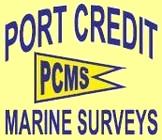 Port Credit Marine Surveys & Yacht Delivery Society of Accredited Marine Surveyors 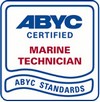 American Boat & Yacht Council  Canadian Power & Sail Squadron  BoatUS ®  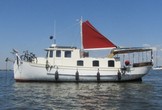 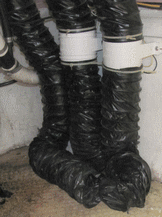   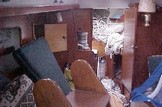 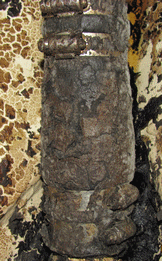  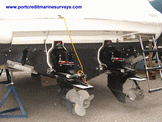  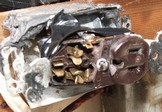 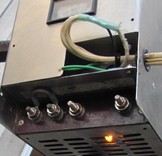  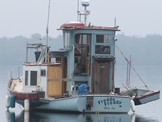 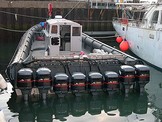 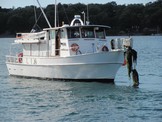   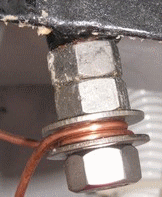  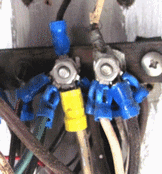 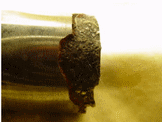   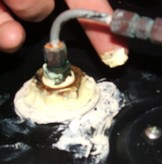 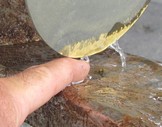 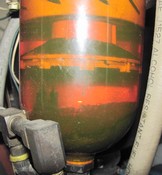 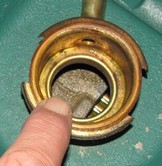 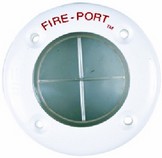   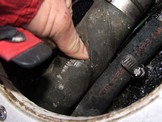  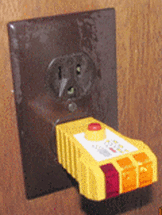
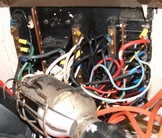     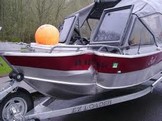   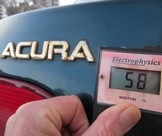   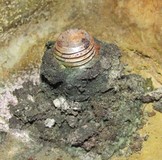 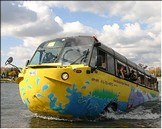   |
STOOPID BOAT TRICKS BY OWNERS A well maintained boat is somewhat of a curiosity. I have thousands of photos like those below and find these examples to be the norm rather than the exception. Many used boats have been modified, re-wired and generally mucked around with by less than expert technicans. One of the last things a surveyor wants to hear is " My buddy is an electrician, he wired it for me". Take a look at the shots below and then decide if your need a SAMS® Accredited Marine Surveyor for your next purchase. Would you want one of these boats in the slip next to you ! |
|
| I took this first photo at Toronto Outer
Harbour Marina. I don't think this one requires
any further comment . I later found out this guy made it from Toronto to Kingston, Ontario. Further proof that Darwin was wrong or this guy's gene pool would have long ago been extinct. |
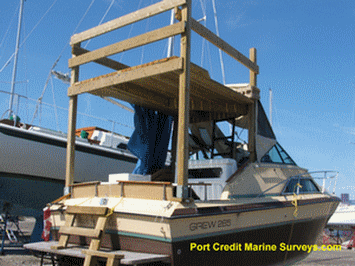 |
|
| When he could no longer tighten his shrouds due to his collapsing mast step, this fella just welded 2" onto the bottom of his mast and started the tightening procedure all over again. | 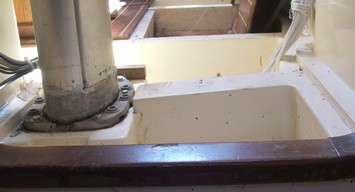 |
|
| This guy lowered his keel for re-bedding
but getting at the keel bolts was too
difficult
so he cut away the 1/2" thick
FRP grid
and hung his keel on the 1/4"
thick
hull skin instead. He didn't even put any backing plates in ..... not that it would help much. |
 |
|
| I noticed some uneveness in the waterline grunge on this 26' boat and that the hull pegged my moisture meter and sounded dull ...... see next photo | 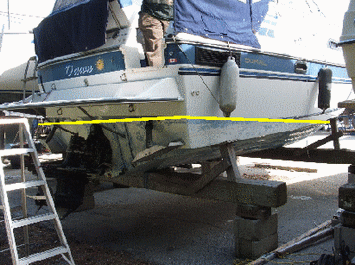 |
|
| His saturated 26' boat would not sit level so he added a 300lb. unsecured plate of steel to the port side of his engine compartment..... in the not too distant future this steel plate will be on the bottom of the lake ..... along with the boat. | 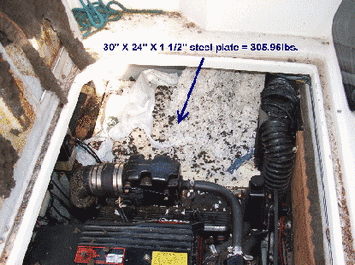 |
|
| Another DIY keel re-bedding gone wrong. Light weight mild steel washers supporting a 3500lb. keel on a 1/4" thick skin. Surely even those without an engineering background can see the folly in this. | 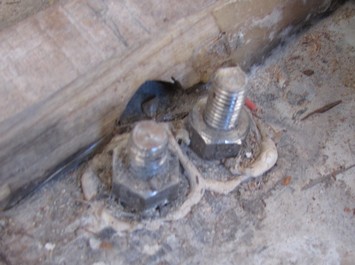 |
|
| By far the most common issues I see are electrical.
How can anyone look at this and think
its
safe to take the kids out fishing ? C'mon clean this up before you hurt someone. |
 |
|
| AC fuses (illegal on a boat), solid copper conductors, AC & DC conductors wrapped around a gasoline fuel line right next to a non-ignition protected, automotive type battery charger. | 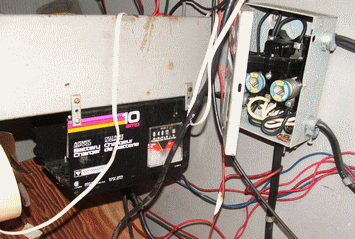 |
|
| At least this guy made an attempt to secure his automotive type charger. |  |
|
| The owner proudly displayed his 2800 amps
of unsecured, unventilated explosive power
in an unventilated compartment with a non-ignition
protected battery charger. It takes a huge charger or alternator to charge a bank of batteries this size and they will produce a significant amount of hydrogen while charging. Static discharge alone could blow this sky high. He needs a huge "No Smoking" sign. He might also consider reading up on hydrogen bombs. |
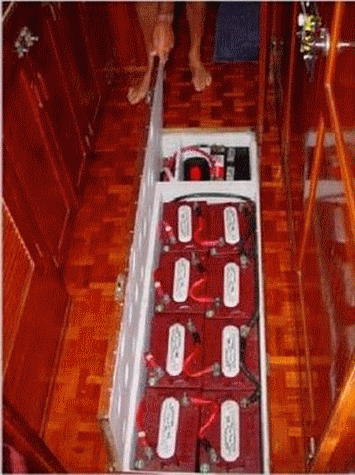 |
|
| Ok, so are you getting the hang of this now
? There are six things wrong in this picture. Can you pick them out ? |
 |
|
| This 165lb. 8D battery mounted on its side
(its an AGM) was held in place (sort of)
by the broken plastic strap. The terminals
are not protected, it's not in a tray to
capture electrolyte and it's in an unvented
compartment with a non-ignition protected
inverter. When the unprotected battery terminals bump against the inverter what do you think is going to happen ? I wonder if the insurance company will pay up when this one goes off. |
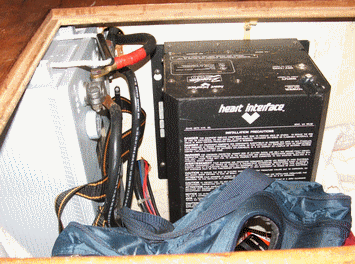 |
|
| Whadayathink ...... is that foam material
fire proof ? Fortunately he does have a fire extinguisher handy. |
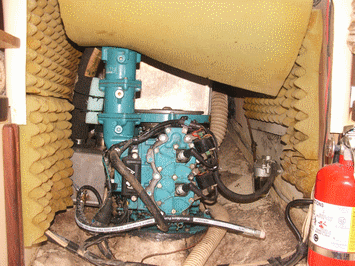 |
|
| Tell ya what...... Lets put a charger/inverter that generates a lot of heat in an unventilated compartment and then cover it with a bunch of flammable stuff ! |
 |
|
| Even though half the wires in this photo were melted and over a plastic portable gasoline tank fitted as a permanent installation, everything still worked. Note the unsecured vent line that vents directly into the mass of melted wires. Again Darwin was wrong ! Owner says "not a big deal". |  |
|
| See the dark rectangle area at upper left ? Thats a louvered vent that vents engine compartment gasses into the saloon. or how about the non-ignition protected AC outlet in this gasoline engine compartment. or how about the unsecured AC conductor lying on top of the engine. |  |
|
| This unsecured battery positive terminal
is going to create a helluva light show when
the positive terminal bumps against that
generator. Other features ..... wing nuts, no positive terminal protection, no fuses in the positive conductors, no trays or boxes to contain spilled electrolyte. |
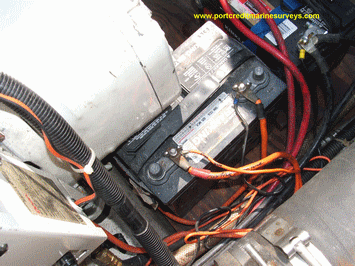 |
|
| Every time the thermostat in this domestic
type water heater cycles, there is
a spark. Sooner or later there will be gasoline fumes and a spark at the same time. |
 |
|
| Same thing with the back side of this domestic type heater. |  |
|
| It's likely that some of the junk in this cockpit locker will eventually come in contact with these unprotected AC connections. | 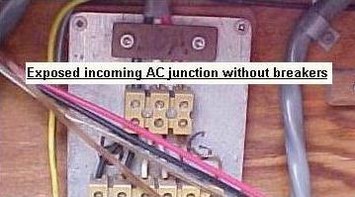 |
|
| I see this so often I had to show you a few pictures. Once again we have AC outlets in the gasoline engine compartment, wing nuts on the conductors, No positive terminal protection, improperly coloured conductors, no fuse protection and non-ignition protected, non AC/DC isolated auto store battery chargers. These chargers are not ignition proteced ie. they spark ! and you get sparks every time you connect or disconnect from the battery terminals with those alligator clips. These type of chargers do not typically have isolated AC and DC sides and will likely cause serious corrosion to outdrives through stray current. or even Electric Shock Drowning. | ||
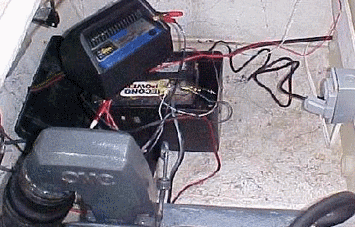 |
 |
|
 |
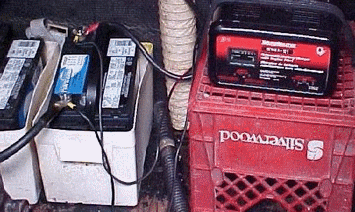 |
|
| A non-ignition protected stereo amplifier immediately under the fuel manifold ! |  |
|
| Three wet cell batteries in compartments that vent into a compartment with a non-ignition protected stereo. Conductor colours are improper, wing nuts secure some conductors, batteries are not in containers resistant to electrolyte and no fuse protection is fitted. | 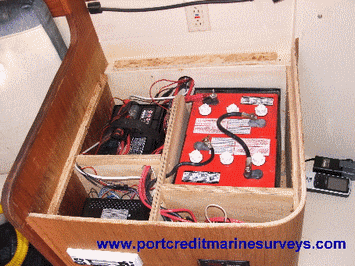 |
|
| Unfortunately I put my finger down to see
what the leak stain was before I uncovered
the batteries. It was electrolyte, otherwise known as sulfuric acid. One very badly burned finger later I found ..... Battery compartment vented into galley, wing nuts securing conductors, no means of securing batteries and need I say, no fuses nor tray or box to catch electrolyte. |
 |
|
| This boat had one 30amp service connected
directly to an AC outlet (no circuit
breaker)
that then spawned 11 outlet multipliers
and
21 extension cords. Note that the outlet multiplier shown has another multiplier plugged directly into it for a total of 11 outlets at this point alone. From this one service without circuit protection there were a total of 36 outlets available for this guy to burn down the entire marina. |
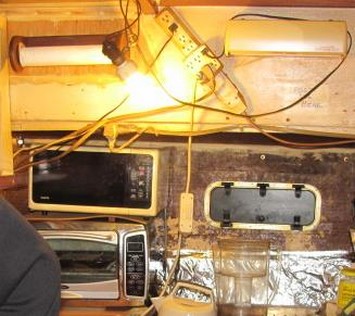 |
|
| Lithium batteries are everywhere, your phone,
your laptop and in that brand new Tesla
sitting
in your driveway. Unfortunately any
fool
can buy lithium cells and build their
own
batteries like this guy did. The two stainless steel boxes contain the lithium cells which are also connected to the two AGM (yellow) batteries and all are charged off of a cheap auto store charger. Note the conductors are twisted together and covered with white duct tape. As soon as I saw this I left the boat and refused to go back on til' everything was disconnected. Boeiing had a much better installation than this and it still cost them a few billion dollars when their 787's started bursting into flames.. |
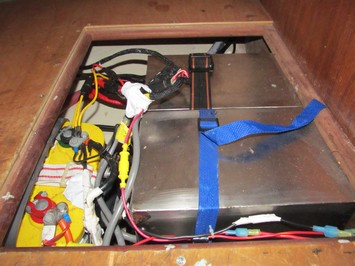 |
|
| Right in the owners manual of your I/O drive
it says if bottom paint touches your
drive,
your warranty is void. Dosn't anyone
read
their manuals ? Many bottom paints contains metal compounds which can set up a galvanic cell and corrode your drive. Drive on right is done correctly. Drive on left has been removed as it was completely corroded. |
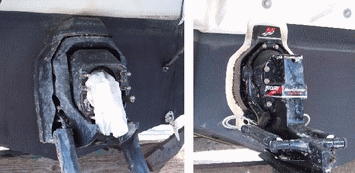 |
|
| Owner sealed this diesel fuel fitting with caulking ..... he couldn't figure out why his boat stunk of diesel. | 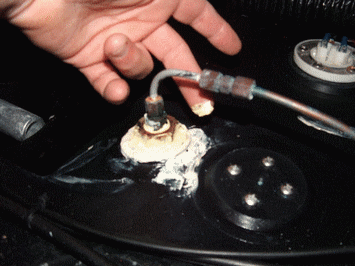 |
|
| Multiple fractures in gasoline fuel lines
jammed against a positive battery conductor. OK, the factory probably did this but dosn't anyone look at their hoses once in a while ? |
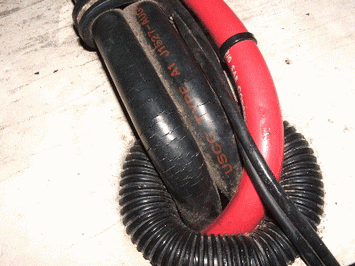 |
|
| Domestic, natural gas furnace with propane fuel supplied from two 20lb. tanks in the saloon of a sailboat. If you can read this article without assistance I'm sure no further explanation is needed. | 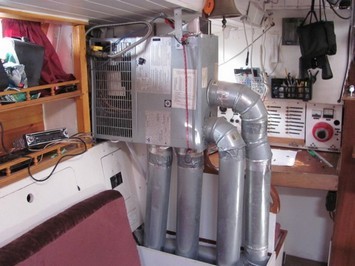 |
|
| Yes Toto we are not in Kansas anymore. That is a custom made propane tank holder in the cockpit of a sailboat which is exposed to the non-ignition protected environment of the diesel engine compartment. |  |
|
| The owner of this sailboat did not understand why he could not use his bilge as a propane locker... "I only connect it when I'm using the stove" |  |
|
| Yes, it's below the waterline. |  |
|
| I see this so often I had to include another
one. Transport Canada, Small Craft Construction Standards TP1332E requires that " Means shall be provided for positively shutting off all underwater penetrations (except for wet exhaust systems) ". Think this cork qualifies as "reliable" ? If you enjoyed this you may want to look at these ... Stoopid Tricks By Boat Builders Stoopid Tricks By Marine Surveyors |

|
|